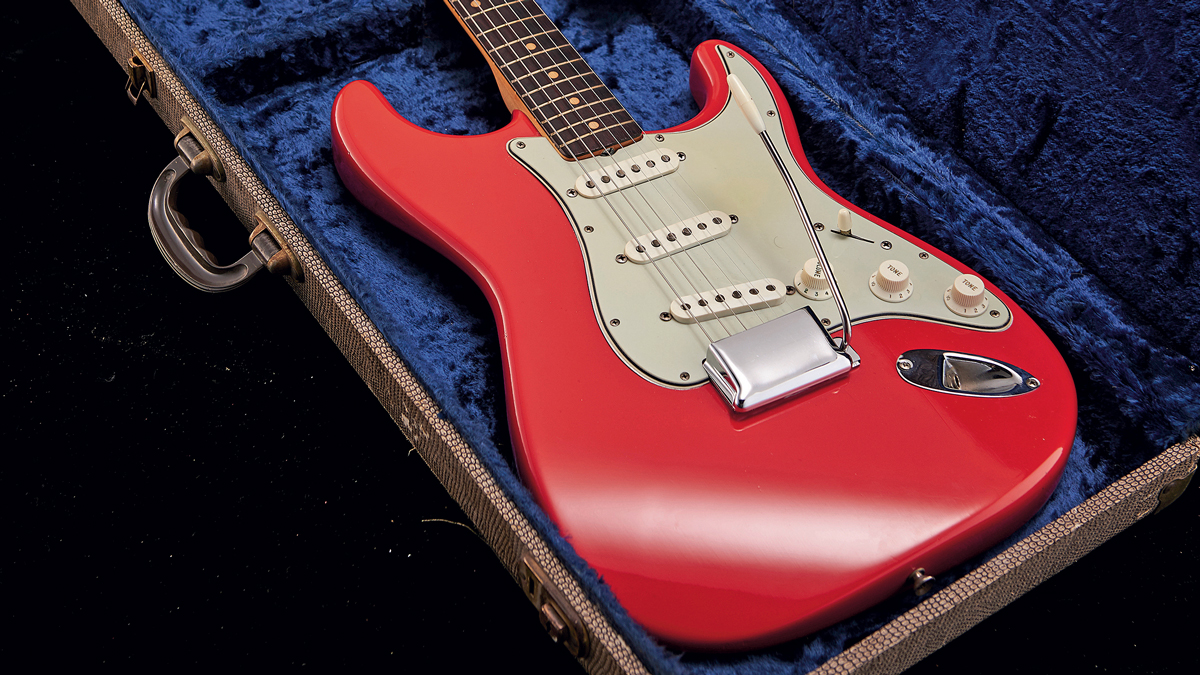Classic gear: 1960s Fender Stratocasters
The Strat continues its journey towards iconic status as a new decade unfolds

By the beginning of the 1960s, the Stratocaster had already experienced its most significant changes. In 1959, rosewood fretboards with ‘clay’ dot markers superseded the guitar’s initial fretted maple-neck design, and an 11-hole, three-layer ‘mint green’ nitrate pickguard replaced the original eight-hole, single-layer white plastic ’guard.
The first rosewood fretboards had a flat base and are thus referred to as ‘slab’ fretboards. Slab ’boards can be easily identified at either end of the neck, exhibiting a downwards curve at the headstock. In August 1962, Fender began using a curved-base veneer rosewood fretboard, which became thinner the following year. Contrary to slab ’boards, veneer ’boards display an upwards curve at the headstock end.
By 1960, Fender had addressed the issue of fading that occurred with the red aniline layer of its three-tone sunburst finish introduced earlier in 1958 (prior to this, Strats came with a two-tone dark brown/yellow sunburst as standard). By 1961, the dark brown outer layer became even darker giving the finish a somewhat bolder look overall.
The sunburst changed appearance yet again in 1964 when Fender began spraying the bodies yellow in addition to using a yellow dip-dye. These vibrant ‘target burst’ finishes appear more opaque and are therefore better able to mask visual imperfections in the guitar’s alder body.

In 1961, Fender introduced its first custom-colour chart, enabling customers to order a Stratocaster in their choice of 14 different shades in addition to Blond and the standard sunburst finish.
These DuPont automotive paint colours included: Daphne Blue, Sonic Blue, Black, Sherwood Green Metallic, Foam Green, Surf Green, Fiesta Red, Dakota Red and Shell Pink nitrocellulose/Duco, along with Lake Placid Blue Metallic, Shoreline Gold Metallic, Olympic White, Burgundy Mist Metallic and Inca Silver Metallic acrylic/Lucite. Custom colours worked a treat to help popularise the Strat, and sales steadily increased throughout the decade.
1960
5-digit serial numbers; black-bottom pickups; formvar coil wire; ‘spaghetti’ logo
1961
Headstock patent numbers; thicker C-profile neck
1962
Brazilian rosewood veneer fretboard; L-prefixed serial number (late ’62)
1963
Thinner fretboard veneer; pickguard screw adjacent to middle pickup
1964
Grey-bottom pickups; enamel coil wire; ‘transition’ logo (gold/black outline); pearloid dots
1965
New pickguard plastic; ‘F’-stamped neckplate, 6-digit serial number & flared headstock (late ’65)
1966
‘F’ logo tuners (most still with ‘double-line’ Kluson Deluxe brand); Indian rosewood fretboard
1967
Optional maple fretboard advertised; CBS logo (black/gold outline); large model name decal
1968
Polyester finishes
1969
Nine remaining custom colour options (including Blond)
Also, in ’61, the Strat’s neck profile became thicker (albeit not as chunky as the rounded- and V-profile neck guitars made between ’54 and ’58). From this point onwards, Strats retained an approximation of a modern C profile, with relatively minor changes occurring throughout the 60s.
All the latest guitar news, interviews, lessons, reviews, deals and more, direct to your inbox!
The same year, two patent number decals appeared on the headstock, increasing to five by 1965. In 1964, a thicker gold/black outlined ‘transition’ logo replaced the original thin ‘spaghetti’ logo. Late the following year, the Strat’s headstock was widened and a couple of years after that was adorned with a new black/gold outlined CBS-designed Fender logo, which appeared alongside an enlarged model name decal featuring solid black block lettering.
By 1968, Fender began using polyester finishes as a way of speeding up production and sustaining its instruments’ clean appearance for longer. In the automotive industry, nitrocellulose lacquer had largely been replaced by more stable, harder-wearing materials by then, and Fender moved with the times.
These thicker finishes changed the look and feel of the Strat – and many will argue the sound of it, too – although this didn’t slow down the momentum of rock ’n’ roll in the slightest, as the era of hard rock really got underway. Indeed, Hendrix almost single-handedly elevated the Strat to unprecedented levels of popularity – poly finishes and funky flared headstocks or not.
- Guitarist would like to thank Vintage ‘n’ Rare Guitars in Bath.
Rod Brakes is a music journalist with an expertise in guitars. Having spent many years at the coalface as a guitar dealer and tech, Rod's more recent work as a writer covering artists, industry pros and gear includes contributions for leading publications and websites such as Guitarist, Total Guitar, Guitar World, Guitar Player and MusicRadar in addition to specialist music books, blogs and social media. He is also a lifelong musician.

